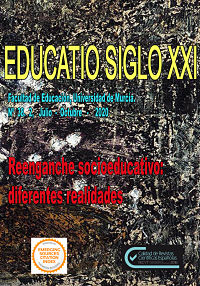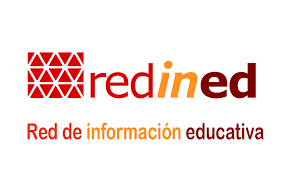Educational re-engagement programs and organizational conditions for their implementation: the importance of the curricular coordination
Abstract
This contribution derives from an investigation project where re-engagement programs for young students in situation of vulnerability with positive results (an increase in the engagement of their learning and educational and social-occupational reintegration) are analyzed. It explores organizational aspects, in particular coordination among teachers, in two educational contexts in the Region of Murcia (Spain): Training Centers and Basic Vocational Training Schools. The study reports on the practical development of the coordination processes found within the above-mentioned two contexts. Theoretical Framework: It articulates on two pillars: 1) processes for school improvement and organizational conditions to enable them, 2) influence of specific educational and organizational systems on disengagement dynamics. Methodology: "Multiple-cases of multiple-units" design. Although different instruments for the collection of information were designed, the study reports solely on the semi-structured interviews conducted with the professionals involved. Results: The mechanisms and dynamics of coordination, looked at from an organizational perspective, stand out as complex but fundamental pillars of these programs, whether they present some limitations related to curricular aspects. Conclusions: Coherence and curricular relevance reveal themselves as one of the weakest points of coordination. This is aggravated by the division into departments typical of Secondary High Schools. Their complexity requires more functional coordination scopes.
Downloads
-
Abstract1810
-
PDF (Español (España))1133
References
Allensworth, E. (2012). Want to Improve Teaching? Create Collaborative, Supportive Schools. American educator, 36 (3), 30-31
Artiles, A. J., & Kozleski, E. B. (2016). Inclusive education’s promises and trajectories: Critical notes about future research on a venerable idea. Education Policy Analysis Archives, 24(43).
Bielby, G.; Judkins, M.; O’Donnell, L. &McCrone, T. (2012). Review of the Curriculum and Qualification Needs of Young People who are at Risk of Disengagement (NFER. Research Programme: From Education to Employment). Slough: NFER.
Björn, J. (2019). Dropping Out of school. A systematic and integrative research review on risk factors and interventions. Örebro University: Working Papers and Reports Social work 16.
Bolivar, A. (2012). Políticas actuales de mejora y liderazgo educativo. Málaga: Aljibe
Bryk, A.S.; Sebring, P. B.; Allensworth, E.; Luppescu, E. & Easton J. K. (2010). Organizing Schools for Improvement: Lessons from Chicago. The University of Chicago Press
Chenoweth, K. (2017). Schools That Succeed: How Educators Marshal the power of systems for improvement. Cambridge, MA: Harvard Education Press
Coffman, S. E. (2018). The High School Experience: Impacts of Parent Involvement on Student Motivation and Engagement. Inter-Text: an undergraduate journal for social sciences and humanities. 1(6).
DeAngelis, K. J. y Presley, J.B. (2011). Teacher Qualifications and School Climate: Examining Their Interrelationship for School Improvement,” Leadership and Policy in Schools 10 (1), 84–120.
Escudero, J. M. (2016) (comp.). Inclusión y exclusión educativa. Realidades, miradas y propuestas. Valencia: Nau Llibres
Escudero, J.M. y González. (2013). Estudiantes en riesgo, centros de riesgo: Dimensiones, interpretaciones e implicaciones prácticas. En J. M. Escudero (coord.) Estudiantes en riesgo, centros escolares de riesgo: Respuestas educativas al alumnado en situaciones de vulnerabilidad (pp. 13-46). Murcia: DM.
González, M.T. (2015). Los centros escolares y su contribución a paliar el desenganche y abandono escolar. Profesorado. Revista de Currículum y Formación del profesorado, 189 (3), 158-176
González, M.T. (2017). Desenganche y abandono escolar y medidas de re-enganche: algunas consideraciones. Profesorado. Revista de Currículum y Formación del profesorado, 21 (4), 17-37.
González, M.T. (coord.) (2015a). La vulnerabilidad escolar y los Programas de Cualificación Profesional Inicial. Apuntes para la Formación Profesional Básica. Madrid: Wolters Kluwer
González, M.T. y Moreno, M. (2013). Análisis del Programa de Garantía Social. En J. M. Escudero (coord.) Estudiantes en riesgo, centros escolares de riesgo: Respuestas educativas al alumnado en situaciones de vulnerabilidad (pp. 221-283). Murcia: DM
González, M.T. y San Fabián, J.L. (2018). Buenas prácticas en medidas y programas para jóvenes desenganchados de lo escolar. REICE. Revista Iberoamericana sobre Calidad, Eficacia y Cambio en Educación,16 (1), 41-60.
Hargreaves, A. (1996): Profesorado cultura y postmodernidad. Cambian los tiempos, cambian los profesores.Madrid: Morata
Harris, A. (2002). School Improvement. What’s it for schools? London: Routledge /Falmer
Henderson, A. T. & Mapp, K. L. (2002). A new wave of evidence: The impact of school, family, and community connections on student achievement.Recuperado de https://eric.ed.gov/?id=ED474521
Hopkins, D. (2007). Every School a great school. Realizing the potential of system leadership. Maidenhead: Open University Press
Kethineni, S.; Frazier-Kouassi, S.; Columb, C. y Kimberly, K. (2018). Effectiveness of parent-engagement programs to reduce truancy and juvenile delinquency: A systematic review. Campbell Collaboration.
Marshall, I.A. y Jackman, G. A. (2015) Parental Involvement, Student Active Engagement and the ‘Secondary Slump’ Phenomenon—Evidence from a Three-Year Study in a Barbadian Secondary School. International Education Studies; 8 (7).
McGregor, G.; Mills, M., te Riele, M. y Hayes, D. (2015). Excluded from school: Getting a second chance at a ‘meaningful’ education. International Journal of inclusive education 19 (6), 608-625
Miles, M. B., Huberman, A.M. &Saldaña, J. (2014). Qualitative Data Analysis. A Methos Sourcebook (3ª Ed.). United States of America: Sage
Nieto, J.M. y Portela, A. (2013). Análisis del Programa de Diversificación Curricular.En J. M. Escudero (coord.) Estudiantes en riesgo, centros escolares de riesgo: Respuestas educativas al alumnado en situaciones de vulnerabilidad (pp. 127-220). Murcia: DM.
Wilson, K.; Stemp, K. & McGinty, S. (2011). Re-engaging young people with education and training What are the alternatives? Youth Studies Australia. 30 (4), 32-39.
Yin, R.K. (1994). Case Study Research – Design and Methods. Applied Social Research Methods (Vol. 5, 2nd ed.). Newbury Park, CA.
Zyngier, D.; Black, R.; Brubaker, N. & Pruym, M. (2016). Stickability, transformability and transmittability: Alternative pull-out programs within schools- What the literature says about effective practice and provision for disenfranchised young people. International Journal of Child, Youth and Family Studies 7(2), 178-197.
Original work publishes in this journal is subject to the following terms:
1. Murcia University Press (the publishing house) holds the copyright of the publishes work, and favours and allows their reutilization under the use license stated in point 2.
© Servicio de Publicaciones, Universidad de Murcia, 2015
2. Work is published in the electronic edition under a license (Creative Commons Reconocimiento-NoComercial-SinObraDerivada 4.0 España (legal text). They can be copied, used, disseminated, transmitted and publicly presented, as long as: i) authorship and original publication source is acknowledged (journal, publishing house and URL of the work); ii) are not used for commercial purposes; iii) the existence and specifications of this use license is stated.
3. Conditions for self-archive. Authors are allowed and encouraged to disseminate electronically the pre-pint (before review) and/or post-print (accepted for publication) versions of their work before their publication since that favours earlier circulation and dissemination resulting in an increased chance for the authors to be cited and for the work to reach a bigger share of the academic community. Colour: RoMEO: green.







